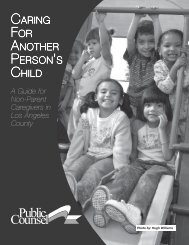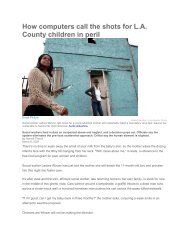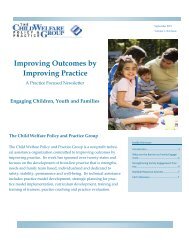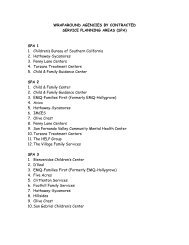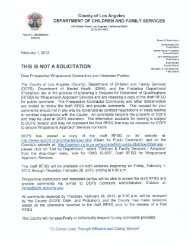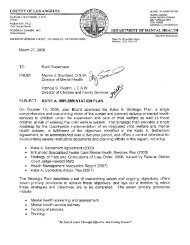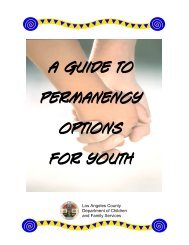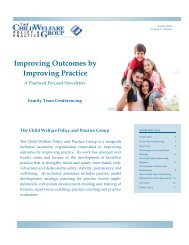Los Angeles County Self-Assessment Report
Los Angeles County Self-Assessment Report
Los Angeles County Self-Assessment Report
You also want an ePaper? Increase the reach of your titles
YUMPU automatically turns print PDFs into web optimized ePapers that Google loves.
<strong>Los</strong> <strong>Angeles</strong> <strong>County</strong> <strong>Self</strong>-<strong>Assessment</strong> <strong>Report</strong><br />
the areas of family functioning in which the family needs to address and improve (based<br />
on the 15,001 FSNAs that were completed by social workers during the calendar year of<br />
2007): Parenting skills (36.6%), substance abuse (27.1%), mental health/coping skills<br />
(22.7%), household relationships (17.4%), social support system (17.1%), resource<br />
management/basic needs (9.4%), physical health (3.3%), culture/community identity<br />
(1.7%), and other identified caregiver need (5.3%). Thirty-five percent of the FSNAs<br />
resulted in no priority needs being reported. It should be noted that there has been a<br />
significant increase in the utilization of the FSNA tool, with a current utilization rate of<br />
78% for the calendar year of 2007, which means that the majority of the families are<br />
having their needs assessed in a systematic manner.<br />
The SDM Child Strengths and Needs <strong>Assessment</strong> (CSNA) requires social workers to<br />
evaluate each child across nine different domains of functioning. Social workers<br />
completed CSNAs for 29,434 children between January 1 and December 31, 2007. Of<br />
those, 10,214 (34.7%) children were between 0 and 4 years old, 10,827 (36.8%) were<br />
between 5 and 11, and 8,393 (28.5%) children were between the ages of 12 and 17<br />
years of age. Only .5% of children in the 0-4 age group exhibited delinquent behavior,<br />
while 2.7% of children in the 5-11 age group and 17.7% of children in the 12-17 age<br />
group displayed needs in this area. Educational needs also increase with the age of the<br />
child, with 1.4% of 0-4 year olds, 15.5% of 5-11 year olds, and 32.5% of 12-17 year olds<br />
showing concern in this area. The areas that required the most attention for<br />
intervention for 0-4 year olds were the quality of family relationships (9.8%), child<br />
development issues (7.1%), medical/physical issues (6.5%), as well as<br />
emotional/behavioral (4.9%) and peer/adult social relationships issues (4.1%). For 5-11<br />
year olds, the areas that needed to be addressed were issues related to education<br />
(15.5%), family relationships (13.5%), emotional/behavioral challenges (11.8%), and<br />
quality of peer/adult social relationships (7.0%). And, finally, for 12-17 year olds, results<br />
show that the greatest areas of need are related to education (32.5%), family<br />
relationships (26.3%), emotional/behavioral challenges (22.1%), delinquent behavior<br />
(17.7%), peer/adult social relationships (13%), and substance abuse (6.8%).<br />
In addition to SDM, family team meetings that are offered by Team Decision Making,<br />
Wraparound, Family Preservation, Family Group Decision Making, Emancipation<br />
Conferences, and Permanency Review meetings all offer the opportunity to thoroughly<br />
assess, with participation by the family and child, the particular services that will be<br />
needed. These processes provide the capability to design a more effective, realistic<br />
individualized case plan along with the family instead of merely prescribing a generic<br />
type of case plan.<br />
Resource Development:<br />
DCFS and its stakeholders agree that efforts are made to strengthen the service array<br />
105



